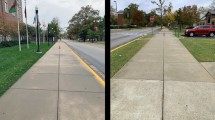Summary
Distance constancy was clearly defined with Thouless and Brunswik indexes by examining its previous definitions. The typical functions expressing the relationships between apparent distance and physical distance were derived from; 1. much available data obtained by many researchers, 2. Thouless and Brunswik indexes (formulas), 3. Luneburg's theory. These derived functions were classified into type I, II and III according to their psychological significance. The validity of the classification was verified by experiments showing that the functions of type III were available in poorly articulated spaces with a long viewing distance, that is, on a housetop and a road, with the method of equal appearing intervals. Moreover, the relationships between distance constancy and personal constants in Luneburg's theory were clarified.
Zusammenfassung
In der vorliegenden Arbeit wird die Entfernungskonstanz nach Überprüfung ihrer früheren Definitionen mit Thouless' und Brunswiks Indexen genau definiert. Die typischen Funktionen, die die Beziehungen zwischen scheinbarer Entfernung und physikalischer Entfernung zeigen, werden abgeleitet aus 1. den verfügbaren Forschungsergebnissen zahlreicher Gelehrter, 2. Thouless' und Brunswiks Indexen (Formeln), 3. Luneburgs Theorie. Diese abgeleiteten Funktionen werden ihrer psychologischen Bedeutung entsprechend in Typus I, II und III eingeteilt. Die Gültigkeit dieser Klassifikation wurde durch Experimente verifiziert, die mit der Anwendung der Methode von gleich erscheinenden Abständen zeigen, daß die Funktionen vom Typus III in ungenügend artikulierten Räumen mit einer langen Beobachtungsentfernung, d.h. auf einem Dach und einem Weg, gültig sind. Außerdem werden die Beziehungen zwischen Entfernungskonstanz und Personalkonstante in Luneburgs Theorie festgestellt.
Similar content being viewed by others
References
Akishige, Y.: Theoretical consideration on problem of perceptual constancies. Bull. Fac. Lit. Kyushu Univ. 7, 1–57 (1961).
—: Perceptual constancy and the law of conservation of perceptual information. Bull. Fac. Lit. Kyushu Univ. 9, 1–48 (1965).
Brunswik, E.: Zur Entwicklung der Albedowahrnehmung. Z. Psychol. 109, 40–115 (1929).
—: Die Zugänglichkeit von Gegenständen für die Wahrnehmung und deren quantitative Bestimmung. Arch. ges. Psychol. 88, 377–418 (1933).
Dornič, S.: Perception and memory in distance estimation. Rep. Psychol. Lab. Univ. Stockh. 242, 1–6 (1968).
Fry, G. A.: Gilinsky's equations for perceived size and distance. Psychol. Rev. 59, 244–245 (1952).
Gibson, E. J., Bergman, R.: The effect of training of absolute estimation of distance over the ground. J. exp. Psychol. 48, 473–482 (1954).
— —, Purdy, J.: The effect of prior training with a scale of distance on absolute and relative judgments of distance over ground. J. exp. Psychol. 50, 97–105 (1955).
Gilinsky, A. S.: Perceived size and distance in visual space. Psychol. Rev. 58, 460–482 (1951).
Gogel, W. C.: Visual perception of spatial extent. J. opt. Soc. Amer. 54, 411–416 (1964a).
—: Perception of depth from binocular disparity. J. exp. Psychol. 67, 379–386 (1964b).
Gogel, W. C., Hartman, B. O., Harker, G. S.: The retinal size of a familiar object as a determiner of apparent distance. Psychol. Monog. 442, 1–16 (1957).
Hagino, G.: New method of determination of personal constants in Luneburg's binocular visual space: I Derivation of theoretical formuli. In: Problems of modern psychology, Depart. Psychol. Hiroshima Univ. (ed.), p. 8–11. Tokyo: Fukumura Press 1968.
Harway, N. I.: Judgment of distance in children and adults. J. exp. Psychol. 65, 385–390 (1963).
Indow, T., Inoue, E., Matsushima, K.: An experimental study of the Luneburg theory of binocular space perception. (1) The 3 and 4-point experiments. Jap. Psychol. Res. 4, 6–16 (1962a).
— — —: An experimental study of the Luneburg theory of binocular space perception. (2) The alley experiments. Jap. Psychol. Res. 4, 17–24 (1982b).
Ishii, K.: Studies on the correlations between various perceptual constancies. Bull. Fac. Lit. Kyushu Univ. 7, 291–314 (1961).
—: Studies on the correlations between various perceptual constancies (II). Bull. Fac. Lit. Kyushu Univ. 9, 335–362 (1965).
Künnapas, T. M.: Scales for subjective distance. Scand. J. Psychol. 1, 187–192 (1960).
—: Distance perception as a function of available visual cues. Rep. Psychol. Lab. Univ. Stockh. 231, 1–10 (1967).
Kuroda, T.: Experimental studies on size constancy. Bull. Fac. Lit. Kyushu Univ. 7, 59–102 (1961).
—: Methodological and experimental studies on size constancy. Jap. Psychol. Res. 5, 188–202 (1963).
—: Experimental studies on size constancy: Mainly concerning with the problem of scaling of apparent size and apparent distance. Annual of Philosophy, Fac. Lit. Kyushu Univ. 25, 23–72 (1964).
—: Methodological and experimental studies on size constancy. Bull. Fac. Lit. Kyushu Univ. 9, 49–96 (1965).
- Studies on distance constancy (2). Proc. 32nd Convention of JPA 113 (1968).
—: Distance constancy: Definition of distance constancy and functional relationships between apparent distance and physical distance. Fac. Law Lit. Kagoshima Univ. 5, 1–43 (1969).
Leibowitz, H.: Relation between the Brunswik and Thouless ratios and functional relations in experimental investigations of perceived shape, size, and brightness. Percept. Mot. Skill. 6, 65–68 (1956).
Luneburg, R. K.: Mathematical analysis of binocular vision. Princeton: Princeton University Press 1947.
Luria, S. A., Kinney, J. A. S., Weissman, S.: Distance estimates with “filled” and “unfilled” space. Percept. Mot. Skill. 24, 1007–1010 (1967).
Oldfield, R. C.: A simplified method of treatment for size-constancy data. Quart. J. exp. Psychol. 12, 33–35 (1960).
Over, R.: Distance-constancy. Amer. J. Psychol. 74, 308–309 (1961).
Purdy, J., Gibson, E. J.: Distance judgment by the method of fractionation. J. exp. Psychol. 50, 374–380 (1955).
Smith, O. W.: Distance constancy. J. exp. Psychol. 55, 388–389 (1958).
Stevens, S. S.: On the psychophysical law. Psychol. Rev. 64, 153–181 (1957).
Tada, H.: Overestimation of farther distance in depth perception. Jap. J. Psychol. 27, 204–208 (1956).
Thouless, R. H.: Phenomenal regression to the real object. I. Brit. J. Psychol. 21, 339–359 (1931). Brit. J. Psychol. 22, 1–30 (1932).
Ueno, T.: The size-distance invariance hypotheses and psychophysical law. Jap. Psychol. Res. 4, 99–112 (1962).
Wohlwill, J. F.: Over constancy in distance perception as a function of the texture of the stimulus field and other variables. Percept. Mot. Skill. 17, 831–846 (1963).
Yokoyama, M., Yamamasu, E.: Perception of length in visual space (4). Proc. 20th Convention of JPA 55–56 (1956).
- - Perception of length in visual space: Depth perception. Proc. 21st Convention of JPA 66–67 (1957).
- - Perception of length in visual space. Proc. 22nd Convention of JPA 65–66 (1958).
Yoshioka, I.: New method of determination of personal constants in Luneburg's binocular visual space: II Determination of personal constants by experiment. In: Problems of modern psychology, Depart. Psychol. Hiroshima Univ. (ed.), p. 12–15. Tokyo: Fukumura Press 1968a.
- Scaling of visual distance. Proc. 32nd Convention of JPA 92 (1968b).
Zajaczkowska, A.: Experimental determination of Luneburg's constant σ and K. Quart. J. exp. Psychol. 8, 66–78 (1956a).
—: Experimental test of Luneburg's theory. Horopter and alley experiments. J. opt. Soc. Amer. 46, 514–527 (1956b).
Author information
Authors and Affiliations
Additional information
I wish to express my thanks to Professor Yoshiharu Akishige for his guidance in this field of work, and Dr. Katsumi Ishii, the retired professor of Kyushu University, for his invaluable suggestions, especially for constant guidance in the problems of Luneburg's theory. Thanks are also due to Assistant Professor Masao Hashiguchi of Kagoshima University for his valuable advice and generous help concerning the mathematical problems. I am also indebted to the students of our department for their help in carrying out the experiments.
Rights and permissions
About this article
Cite this article
Kuroda, T. Distance constancy: Functional relationships between apparent distance and physical distance. Psychol. Forsch. 34, 199–219 (1971). https://doi.org/10.1007/BF00424606
Received:
Issue Date:
DOI: https://doi.org/10.1007/BF00424606




